Offshore lifting: Wind under way
18 January 2021
There is no secret that offshore wind is a fast-growing sector of the renewables market. The Global Wind Energy Council (GWEC) reported in August a 24 percent compound annual growth rate for offshore wind power over the past seven years, and offshore accounted for 10 % of all wind power installations in 2019, which compares to 1 % in 2009.
That rate of growth – being led by China and Europe (especially the UK, Germany, Denmark and Belgium) – is unlikely to be sustained but the Council is estimating an 18.6 % CAGR between 2020 and 2024 dropping to 8.2 % from 2025 to 2030. That will see almost 32 GW of installed offshore wind capacity by 2030, up from 6 GW now.
You can quibble with the growth rates and figures, but there is little doubt that offshore wind is going to be a major opportunity for the lifting and transportation sector over the coming decades, and one that will impact the entire supply chain, from offshore crane manufacturers, shipping specialists and marine consultants, to turbine manufacturers, barge owners and specialist heavy lift companies.
That opportunity is making itself felt in all kinds of ways, including a steady flow of new joint ventures, investment announcements, and at a more detailed level, the development of technical innovations to make offshore turbine installation safer and more efficient.
New spending
One company investing in the sector is specialist contractor Offshore Heavy Transport (OHT). The Norwegian business has ordered a pair of jack up heavy lift installation vessels designed for wind turbine work. They will be a designed by GustoMSC – a part of the National Oilwell Varco (NOV) group – and each will have a 2,500 tonne capacity crane with a lifting height of 165 metres. Installation will be possible at depths up to 65 metres, OHT says.
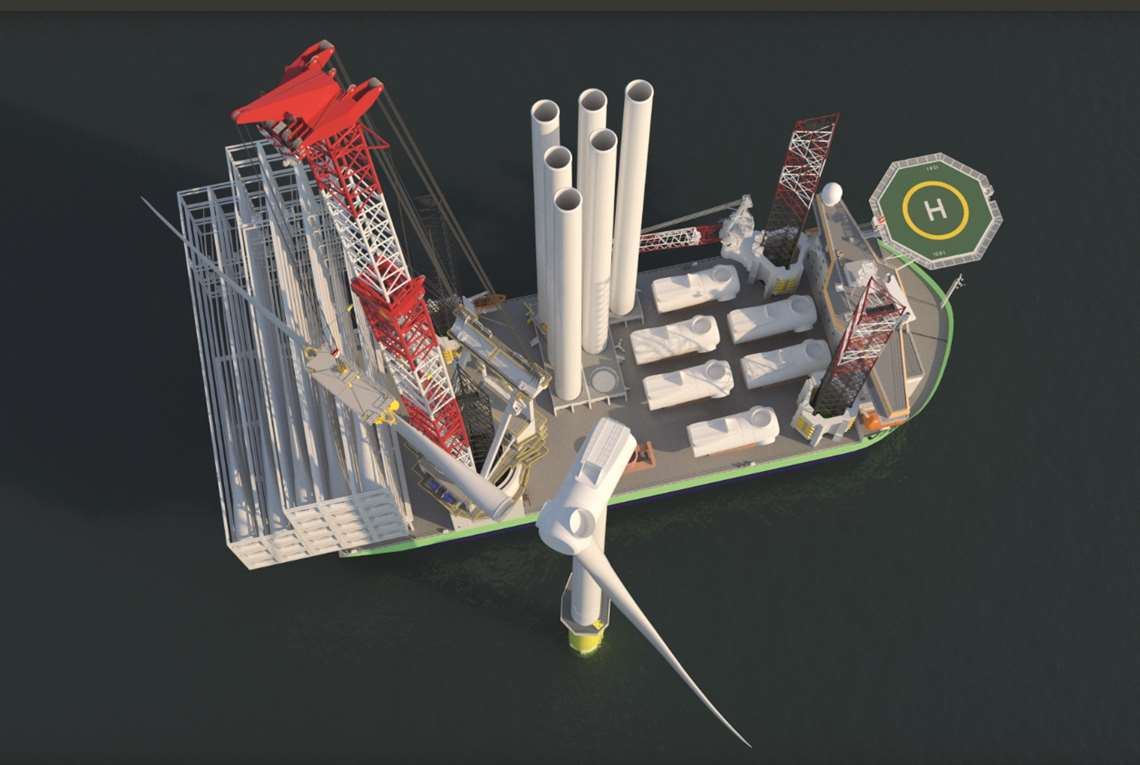 Norway’s Offshore Heavy Transport (OHT) aims to be a fully integrated transport and installation company for offshore wind
Norway’s Offshore Heavy Transport (OHT) aims to be a fully integrated transport and installation company for offshore wind
The cranes are of an interesting telescopic lattice boom design. Torgeir Ramstad, OHT chief executive, explains; “In retracted mode, capacity of the telescopic leg encircling cranes is 2,500 tonnes with a hook height above deck of approximately 120 metres.
“In retracted mode, a split hook mechanism ensures faster operation at a capacity up to 1,250 tonnes with a lifting height that will enable hub heights of 165 metres and more. The boom is a lattice structure where the extension segment is pulled out of the lower boom structure (both box-shaped) while being supported by rollers.”
OHT said they will be built by China Merchants Heavy Industry (CMHI) in Jiangsu, China. There is an option for another two vessels for OHT’s subsidiary VIND Offshore Installation AS. The first unit will be delivered in early 2023, OHT says, with flexible delivery on the second unit.
“Through this initiative”, Ramstad explains, “OHT firmly establishes its position as a leading, fully integrated transport and installation company for offshore wind. In doing so, we are responding to client concerns about the lack of capable vessel capacity in the booming offshore wind market.”
OHT is known for offshore heavy transport, including some of the world’s heaviest and largest structures, mostly in the oil and gas industry. A current project is Moray East off the coast of Scotland, UK, where OHT is transporting 48 jacket foundations from the UAE.
We also previously reported in ICST that Abnormal Load Services (ALS) and NorSea have recently created a new company Elevon to focus solely on wind energy industry logistics.
Knut Magne Johannessen, the long-time NorSea executive who took up the post of Elevon CEO in June, says, “Big opportunities need a singular focus. The pure-play strategy allows Elevon to anticipate and respond quicker to client needs, attract industry-specific talent, go ‘all-in’ in tailoring operations for wind project delivery, and make very specific investments to support clients in the wind industry.”
The lack of appropriate vessels to support offshore wind – noted by OHT above – is something that is triggering action. For example, United Wind Logistics (UWL), based in Hamburg, Germany, has taken delivery of the first of two deck carriers, MV BoldWind, with the second to follow later this year.
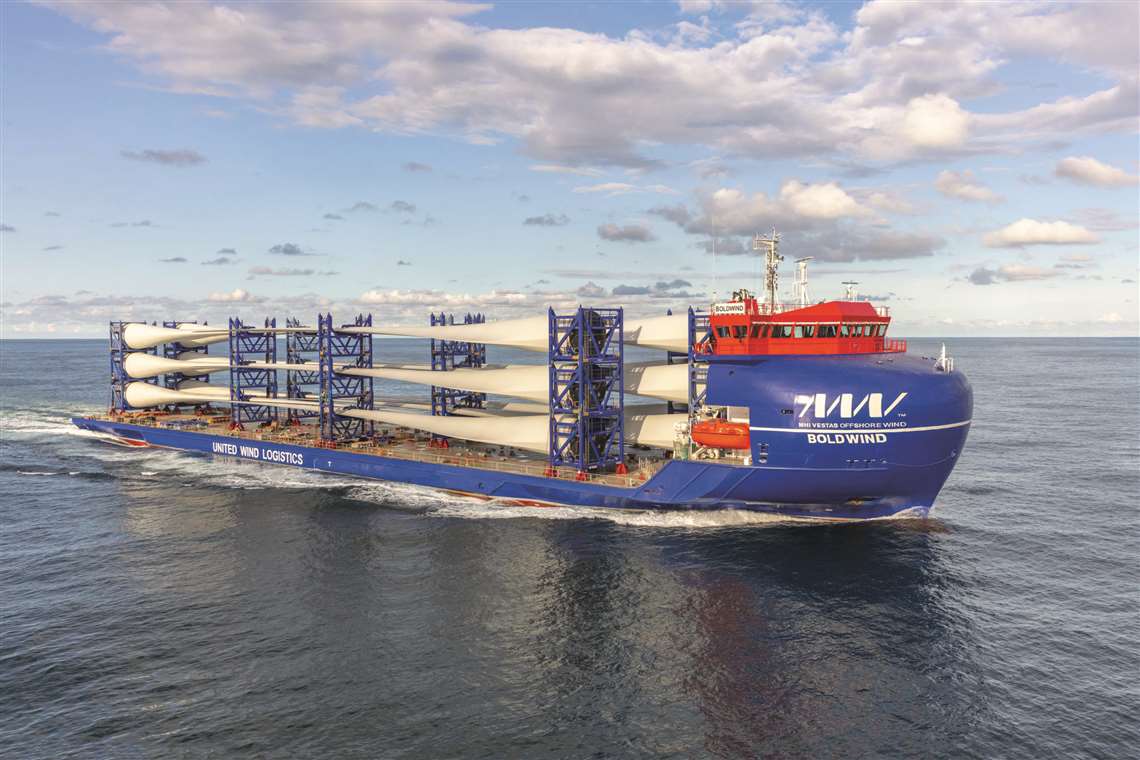 United Wind Logistics (UWL) has taken delivery of the first of two deck carriers, MV BoldWind, with the second to follow later in 2020
United Wind Logistics (UWL) has taken delivery of the first of two deck carriers, MV BoldWind, with the second to follow later in 2020
The vessel will start her maiden voyage towards Europe, where she will be employed in a long-term charter in the offshore wind industry. On this voyage she will carry wind turbine blades from China to Norway.
With a deadweight of 10,000 tonnes, a deck length of 128 metres and width of 28 metres, the deck carrier offers great flexibility for any huge or heavy cargo. It combines an optimised hull design and diesel electric propulsion system supplied by ABB and powered by four MAN diesel generators. In addition, the MAN engines meet IMO Tier III emission regulations, having a selective catalytic reduction system.
More vessels
Also building vessels is Belgium-based DEME Wind engineering and Taiwanese shipbuilder CSBC, who have created a joint venture, CDWE, described as Taiwan’s first offshore wind contractor. Earlier this year the venture agreed to build Green Jade, the first floating DP3 class heavy lift and installation vessel to be built in Taiwan.
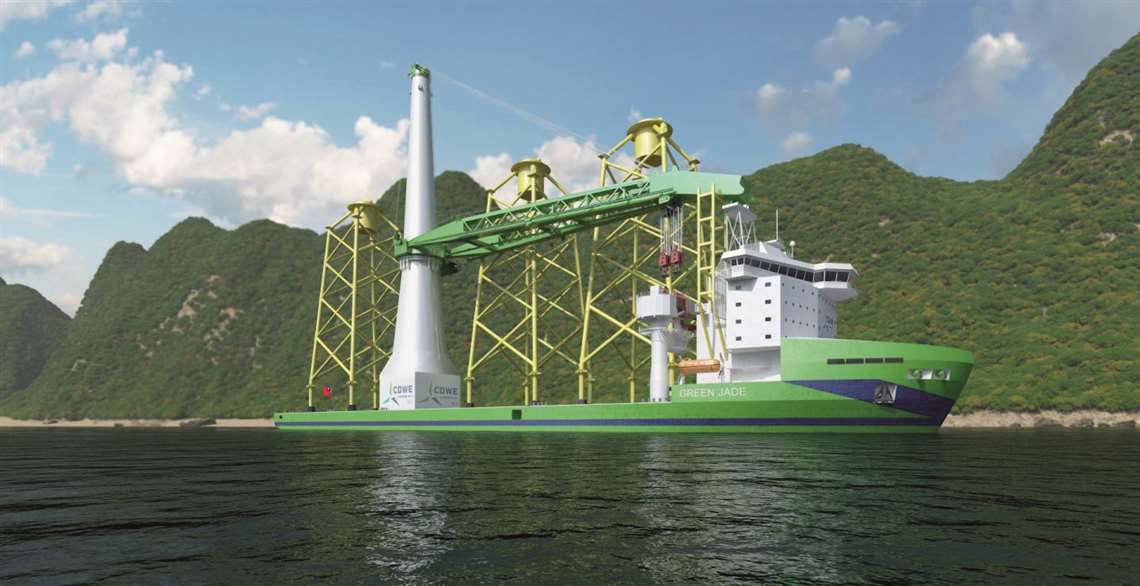 The CDWE joint venture between DEME Wind Engineering and Taiwan’s CSBC is building Green Jade, a floating heavy lift and installation vessel
The CDWE joint venture between DEME Wind Engineering and Taiwan’s CSBC is building Green Jade, a floating heavy lift and installation vessel
The vessel will be built at CSBC in Kaohsiung and delivery is scheduled for 2022. With a 4,000 tonne crane capacity and DP3 capability, the vessel is designed to serve the renewables market, allowing CDWE to transport a multitude of the heaviest monopiles, jackets, wind turbine components and structures in a single shipment.
Green Jade will be deployed for both the Hai Long Offshore Wind Project and at Zhong Neng for Zhong Neng Wind Power Corp. CDWE signed a preferred supplier agreement with Hai Long Offshore Wind Project in October 2019 and for Zhong Neng, with the contracts comprising the transportation and installation of foundations.
Robert Tseng, CDWE chairman, says, “With Green Jade we will be uniquely positioned to meet the future requirements of our customers and the trend towards larger capacity turbines and bigger wind farm projects, which deliver energy at lower costs. Green Jade will be capable of installing mega monopiles and jacket structures at greater water depths.”
Yet another ship investor is Danish company Swire Blue Ocean (SBO), which intends to order a new wind farm installation vessel (WIV) with an option for a second new-build. It is also planning to invest in new cranes for both its Pacific Osprey and Pacific Orca vessels.
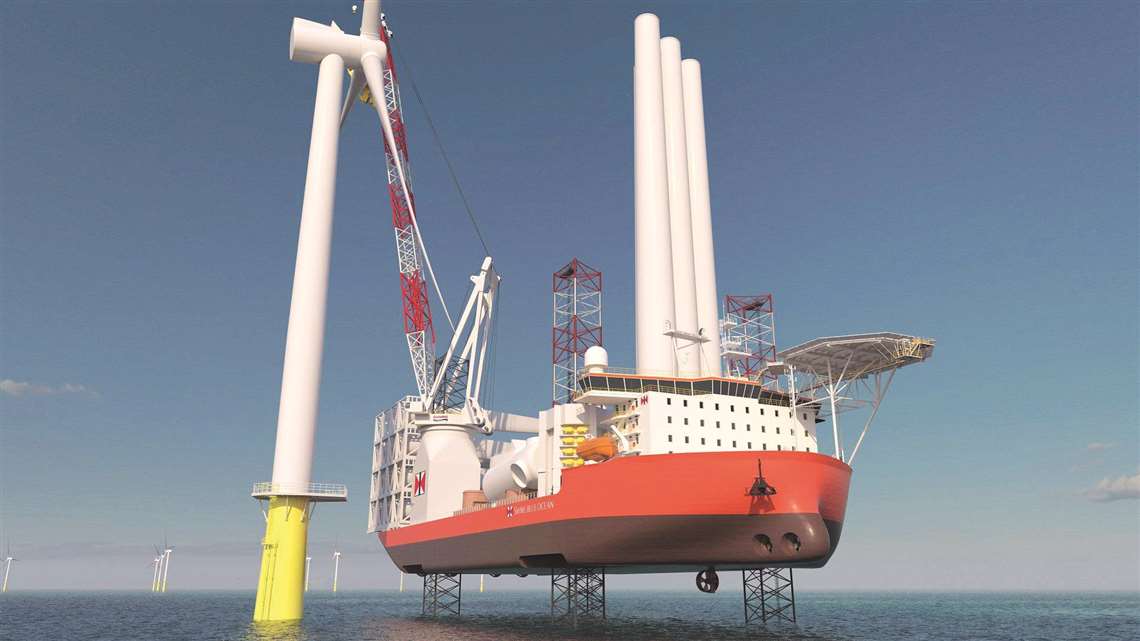 Swire Blue Ocean (SBO) said its new wind farm installation vessel – being developed with GustoMSC – will have capacities unseen in the industry up to now
Swire Blue Ocean (SBO) said its new wind farm installation vessel – being developed with GustoMSC – will have capacities unseen in the industry up to now
SBO says the new vessel will have capacities unseen in the industry up to now. The vessel design, created in partnership with GustoMSC, is a bespoke version of the self-propelled jack-up NG-20000X-G design. That vessel has a crane capacity of 2,500 tonnes, retracted, and an above deck lifting height of 121 metres.
“I am proud to announce that our organisation has put in the hard work to understand the challenges the industry faces, and is now equipped to deliver a solution which will prevent a supply chain bottleneck when new turbine models reach the market in the mid-2020s,” said Mikkel Gleerup, CEO at SBO.
Over the past year, SBO has also focused on replacing the main cranes on its ’O class’ wind turbine installation vessels.
Its engineers and project partners have developed a crane that is designed to offer a maximum load moment rating of 100,000 tonne-metres, while maintaining the vessels’ capacity to jack up on difficult sites and weather treacherous offshore conditions. The main cranes are designed to provide up to 1,600 tonnes of lifting capacity with a 155 metre hook height above deck.
These specifications are expected to meet the requirements for installation of all turbine models currently under development and allow for the continued growth in size and weight of turbine components. Installation of the new cranes is scheduled for the final quarter of 2023.
The USA is behind Europe and China in terms of offshore wind, but that is changing. Dominion Energy, a Virginia, USA-based power and energy company has commissioned Dutch offshore lifting specialist Huisman to fabricate a crane that will be used on what it says will be the first Jones Act-compliant offshore wind installation vessel in the USA. The Jones Act is a federal law that requires shipping between US ports to operate vessels built and owned by US citizens or permanent residents.
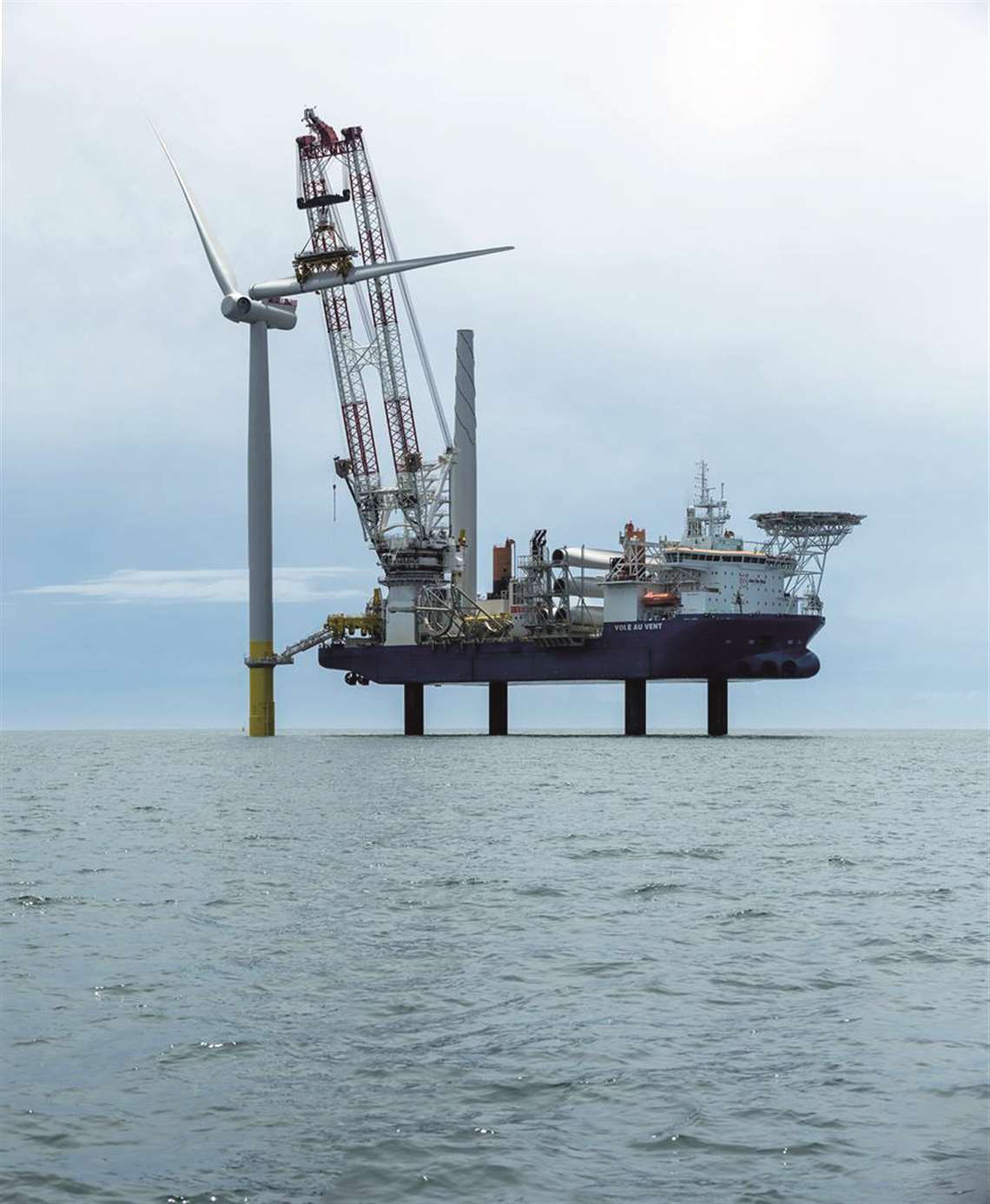 Dominion Energy in the USA has commissioned Dutch specialist Huisman to build a crane for an offshore wind installation vessel in the country
Dominion Energy in the USA has commissioned Dutch specialist Huisman to build a crane for an offshore wind installation vessel in the country
Dominion Energy said a Jones Act vessel is vital for the continued growth of the US offshore wind industry. The crane for the installation vessel will lift 2,200 tonnes, enabling the installation of the new generation of wind turbines.
David Roodenburg, Huisman chief executive officer, said the company was proud to be contributing to Dominion Energy’s ambition to enable large scale offshore wind development in the United States.
Offshore USA
Dominion is also working with other big European players in the US offshore wind sector. Jan De Nul Group is acting as a sub-contractor to Dominion and Ørsted Wind Power North America on the construction of a wind farm 27 miles (44 km) off the coast of Virginia Beach.
Jan de Nul is working on the project with Roll Group, and using its BigRoll vessels. On 31 March the first foundation components for two windmills were loaded onto the BigRoll Beaufort at Rostock in Germany. For safe transport, Roll Group’s engineers designed a grillage that was installed on BigRoll Beaufort in Gdynia, Poland, before loading.
After loading in Rostock, the vessel made a port call in Esbjerg, Denmark, to load the ‘white’ parts, such as the towers and blades. In mid-April she set sail to her final destination in Halifax, Canada. The foundation components will be carried by Jan De Nul’s installation vessel, Vole au Vent, which will sail to the wind farm to install the foundation components. In the meantime, Jan De Nul will assemble and commission the tower sections onboard the BigRoll Beaufort and prepare it for installation by the Vole au Vent.
“This project is important to us,” says Bastian Bojko, operations director Roll Group. “Because it gives us the opportunity to show that [we] has vessels that are highly suitable for the offshore wind industry. Being part of this pioneering and complex project, where our vessel is an integral part of the shipping and assembly scope, shows the true added value we can deliver from a technical and operational perspective.’’
For Philippe Hutse, offshore director of Jan De Nul Group, the contract represents a milestone for the company; “It opens the door for non-US marine companies to work in the United States. Moreover, this wind farm is the first American wind farm located in Federal Waters.”
Back in Europe, big-name contractors Heerema and Saipem are also benefiting from offshore wind projects. Heerema’s SSCV Sleipnir vessel transported and installed the six-legged, 2,858 tonne, and 46 metre tall jacket for the Hollandse Kust Zuid (HKZ) transformer station, part of the HKZ wind farm.
Heerema secured the contract for the project with the jacket and topside main contractor, Petrofac. While the wind farm developer is Vattenfall, and the transformer station is owned by the Dutch grid provider TenneT. SSCV Sleipnir is Heerema’s largest vessel and this is its first job in the wind sector.
Meanwhile, Saipem has been awarded new offshore wind contracts on projects under development off the coasts of England, Scotland and France, for a total value of more than €90 million (US$ 106 million).
Dogger Bank Offshore Wind Farms, a joint venture between Equinor and SSE Renewables, has awarded a contract to Saipem for the transportation and installation of two offshore HVDC (high voltage direct current) platforms for the first two phases of the Dogger Bank project: Dogger Bank A and Dogger Bank B.
Dogger Bank will be the world’s biggest offshore wind farm. It is more than 130 km off the North East coast of England.
Saipem has also been awarded an installation contract by Seaway 7 related to the Seagreen Offshore Wind Farm, a 1,075 MW joint venture project between SSE Renewables (49 %) and Total (51 %) off the east coast of Scotland. The scope of work entails the installation of 114 foundations for the same number of wind turbines.
Francesco Racheli, chief operating officer at Saipem’s E&C offshore division, says, “These new contracts confirm Saipem’s participation in the most relevant offshore wind farm developments and are the tangible results of a strategy which has led us to become a global reference player in energy transition.”
Knock-on effect
Of course, crane manufacturers are also getting work on the back of the offshore wind push. Palfinger will supply knuckle booms cranes and davits for four new service vessels being built in Spain for Edda Wind, Østensjø Group’s offshore wind division.
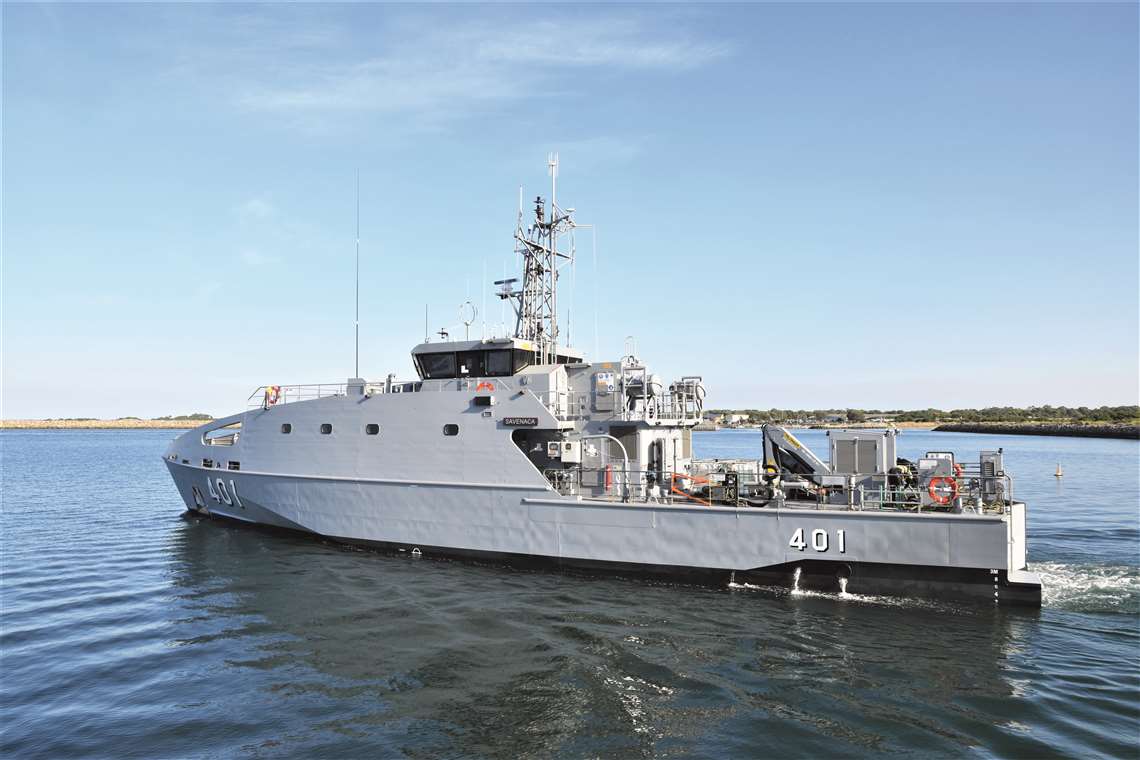 Palfinger’s marine business and local sales and service partner Palfinger Australia is working on a major order for long-term customer Austal, the Australian shipbuilder. By 2023, 21 of its PK15500M foldable knuckle boom cranes will be delivered for use on 21 new Guardian Class patrol boats
Palfinger’s marine business and local sales and service partner Palfinger Australia is working on a major order for long-term customer Austal, the Australian shipbuilder. By 2023, 21 of its PK15500M foldable knuckle boom cranes will be delivered for use on 21 new Guardian Class patrol boats
The order comprises PK1500M and PK33002M cranes for two commissioning service operation vessels (CSOV), and two PK15500M cranes and one PK33002M crane each for two slightly smaller service operation vessels (SOV). Deliveries are scheduled for 2021 and 2022. Edda Wind has signed long time charter agreements with MHI Vestas and Ocean Breeze Energy.
It is clear offshore wind is becoming a rich area for new technology and investment, and it is only just beginning. Even the design of offshore turbines is evolving. For example, there is a growing trend towards floating offshore turbines, as opposed to the current most popular bottom-fixed design. The industry estimates floating installations could represent a third of the total offshore wind output in Europe by 2050. In terms of transport and installation, that’s a different story again.
|
Danish wind turbine manufacturer MHI Vestas and Verton, the Australian company behind a remote-control load orientation device, have partnered to produce new tooling devices to handle loads on offshore lifting operations, including wind turbines. 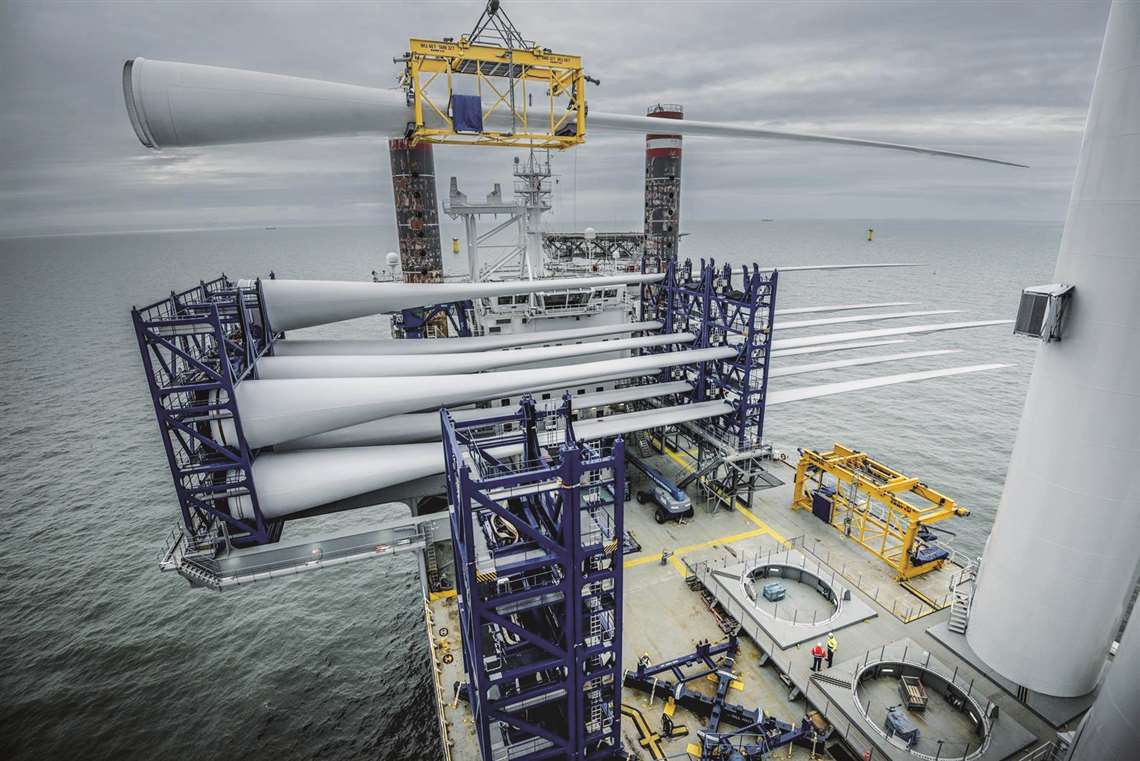
Trevor Bourne, Verton managing director, says there would be significant benefits in integrating its technology in MHI Vestas lifting operations, “Working on offshore sites is difficult enough and is further complicated using taglines to control loads during lifting operations. “Our Columbus 7.5 SpinPod will be capable of precisely controlling the orientation of the custom lifting yoke and its load, including setting and holding a desired orientation, even under the most challenging conditions. “[The system] completely removes the need for taglines and for workers to be near the landing area of loads, greatly improving safety and reducing the number of workers required. The precise orientation control will also enable lifting operations to be completed faster, which is very important in an environment where every minute saved is highly valuable.” |
| Huisman quick connector
Huisman and Jan De Nul Group have joined forces to develop new technology to be used on two offshore cranes being designed for Jan De Nul’s next generation offshore installation vessels Les Alizés and Voltaire. The two say the technology represents a “major step change” in offshore hoisting activities. For the cranes, Huisman has developed the Universal Quick Connector (UQC), drawing on the expertise of Jan De Nul Group’s operational and engineering. The UQC is a modular clamp mounted inside the crane’s lower block which allows the lifting of objects through a direct connection. The connector attaches and detaches loads and tools directly to the crane’s lower block without rigging, and it is hands-free and fully automatic. The complex task of (de)rigging – typically manual assisted – can be prepared outside of the critical path of the lifting operation. The UQC is fitted with an active rotation device increasing operational control when attaching the load. It allows rotation of the load to fine-tune its orientation without additional taglines. This enables the accurate positioning of heavy components as well as wind turbine components with strict bolt pattern tolerances. Robby De Backer, director new building at Jan De Nul Group, says, “With UQC, we provide our offshore installation teams on board of both vessels with a better means to control the lifting operations in a safe way.” |
| Clever winch innovation
National Oilwell Varco Norway AS (NOV) filed a patent in 2016 – published in April 2020 – for an offshore crane for deep sea hoisting applications that incorporates the winch drum and spooling device within the crane’s boom. The system would mean lighter fibre ropes can be used because it removes the need to use very large winch drums required for such ropes. The design also eliminates the need for storage space for drums. As reported in The Journal of Engineering in April, “By arranging the winch drum substantially vertically, the potentially large footprint of a long winch drum may be significantly reduced.” The new design will also make it possible to pre-test the crane winch system onshore before installing the crane offshore. |
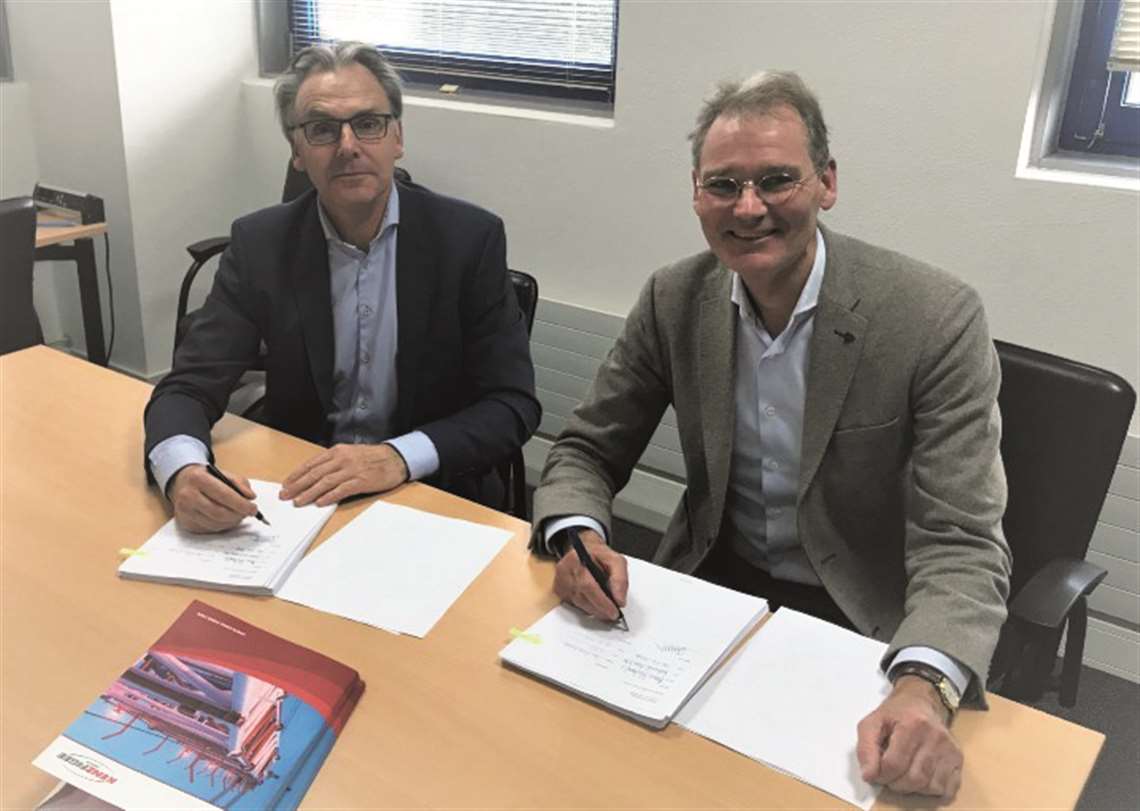
Dutch offshore lifting company KenzFigee has been awarded a contract by Amsterdam shipping company Spliethoff for 140 tonne capacity pipe handling gantry cranes for its two newbuild multipurpose DP2 B-type vessels under construction in China. Pictured are Arne Hubregtse, left, at Spliethoff and Jan-Pieter Klaver at KenzFigee. |
|
Azerbaijan oil and gas company Umid Babek Operating Co. (UBOC) has bought four Liebherr BOS offshore cranes. The order, the first direct sale of BOS cranes to Azerbaijan for Liebherr, comprises two board offshore cranes (BOS) 2600, with a lifting capacity of 45 tonnes at 30 metres onboard, and two BOS 4200 cranes. 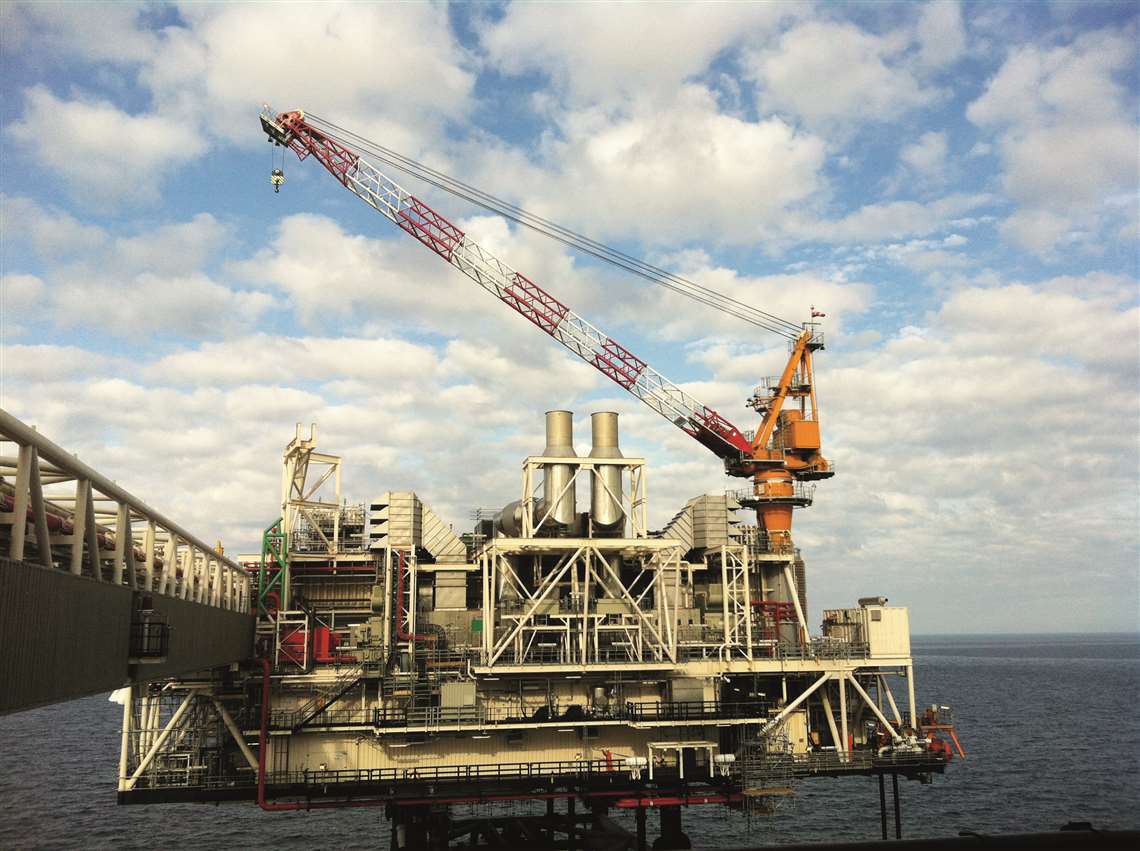 |




